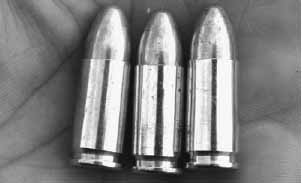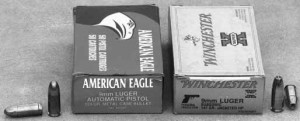
One critical rule of firearms safety is that the bullet must stay in its intended backstop. No responsible shooter would go to one of the older indoor shooting ranges that have a warning poster saying “LEAD BULLETS ONLY, JACKETED BULLETS CAN PIERCE BACKSTOP” and then proceed to pump hard-jacketed bullets into that frail backing.
On the street, the only safe backstop for the defensive handgun’s bullets is the body of the offender. Therefore, it is not exactly responsible to be firing bullets that are likely to shoot through the assailant.
This is one of the main reasons law enforcement in its virtual entirety has gone to expanding bullet handgun ammunition in this country.
It was a lesson written in blood.
Hollow Points are No Dummies
In 1999, New York City became almost the last major police department to adopt hollow point ammunition. They did so in the face of huge, long-term opposition based on political correctness and the erroneous perception of hollowpoints as wicked “dum-dum bullets.”

One reason they were able to pass it was that the city fathers had been made to realize how much danger the supposedly “humane, Geneva Convention-approved” ammunition previously used presented to innocent bystanders and police officers when the duty weapons were fired in self-defense or defense of others by the officers.
From the early ’90s adoption of 16-shot 9mm pistols (Glock 19, SIG-SAUER P226 DAO, and Smith & Wesson Model 5946) through 1999, NYPD issued a full metal jacket “hardball” round, comprising a round-nose 115 grain bullet in the mid-1100 fps velocity range.
The New York Times exposed the following facts in its startling report on the matter:
“According to statistics released by the department, 15 innocent bystanders were struck by police officers using full metal jacket bullets during 1995 and 1996, the police said. Eight were hit directly, five were hit by bullets that had passed through other people and two were hit by bullets that had passed through objects,” stated the Times.
In other words, in rough numbers, 53 percent of these tragic occurrences were apparently missed shots, while 33 percent were “shoot-throughs” of violent felony suspects.
Counting bullets that went through objects to hit presumably unseen innocent victims (13 percent), that tells us that roughly 46 percent of these innocent bystanders were shot by over-penetrating bullets that “pierced their backstops.”
The Times continued, “In that same period, 44 police officers were struck by gunfire using the old ammunition: 21 were hit directly, 2 were struck by bullets that ricocheted and 17 were struck by bullets that passed through other people.”
In round numbers, 52 percent of those “friendly fire” casualties were hit by bullets that apparently missed their intended targets. Forty-two percent passed through the bodies of the intended targets after the bullets struck the people they were aimed at.

Deconstructing Shootthrough Fatalities
Why would officers hit more of their own brethren than “civilian” bystanders in this fashion? For the simple reason that while victims and potential innocent bystanders tend to flee danger scenes, the cops are conditioned to “ride to the sound of the guns.”
In a close-quarters situation where a violent criminal is attempting to harm or even murder another officer, cops try to grab him or stop him or even maneuver into a position from which to shoot him.
All these actions can put them in the line of fire of brother officers.

Tunnel vision occurs in a majority of life-threatening encounters. This is the perceptual phenomenon of being able to see only the threat and being unable to cognitively recognize other people or objects that might be in the line of fire.
Moreover, the body of the offender may simply block the shooter’s view of the brother officer who is trying to apprehend or restrain the attacker from behind. In these situations, a “shootthrough” is highly likely to kill or cripple one of the Good Guys and Gals.
What does this have to do with private citizens’ use of CCW handguns? Only this: Where the cops jump in to protect their brother and sister officers, brave citizens may step in to protect their actual brothers and sisters, husbands and wives, sons and daughters, or fathers and mothers. Now it is your loved ones who are behind the offender – unseen by you – when you discharge your CCW weapon.
Those 115-grain jacketed ball 9mm rounds will pierce more than two feet of muscle tissue-simulating ballistic gelatin. So will 230-grain full metal jacket 45 hardball.
By contrast, the depth of the average adult male thorax is probably no more than 10 inches, from front of chest to back. Nor is it solid muscle: the
spongy tissue and large air volume of the human lung offer little resistance to a bullet.
A Real-World Example
Many years ago in Los Angeles, an Aryan Brotherhood thug took several people hostage in an office. He demanded an escape vehicle and threatened to start
shooting hostages if he didn’t get one.
A vehicle was provided, and he got into the car with the victims. At this point, the LAPD SWAT team launched smoke, and two members of the team whom I happened to know moved forward through the gray cloud, their issue Colt 45 automatics up and ready.
When the perpetrator reached for his pistol, the cops opened fire, using department-issue 230-grain hardball. They fired four shots between them, and killed the offender before he could launch a single bullet of his own.
Autopsy showed any of the four hits would have been quickly fatal. However, only one of those bullets stayed in the offender’s body. One of the three exiting slugs struck one of the hostages. Fortunately, the wound was not
in a life-threatening location.
LAPD quickly switched to hollowpoints, which is what they use today. Lesson learned.
Editor's Note: This article is excerpted from The Gun Digest Book of Concealed Carry.

Next Step: Get your FREE Printable Target Pack
Enhance your shooting precision with our 62 MOA Targets, perfect for rifles and handguns. Crafted in collaboration with Storm Tactical for accuracy and versatility.
Subscribe to the Gun Digest email newsletter and get your downloadable target pack sent straight to your inbox. Stay updated with the latest firearms info in the industry.

![Best Concealed Carry Guns In 2025 [Field Tested] Wilson Combat EDC X9S 1](https://gundigest.com/wp-content/uploads/Wilson-Combat-EDC-X9S-1-324x160.jpg)


![Best 9mm Carbine: Affordable PCCs [Tested] Ruger Carbine Shooting](https://gundigest.com/wp-content/uploads/Ruger-Carbine-Shooting-100x70.jpg)
![Best AR-15: Top Options Available Today [Field Tested] Harrington and Richardson PSA XM177E2 feature](https://gundigest.com/wp-content/uploads/Harrington-and-Richardson-PSA-XM177E2-feature-100x70.jpg)

Overpenetration by Richard Mann posted on July 16, 2014 in Shooting Illustrated seems to contradict this opinion.
As a loyal follower of Mas Ayoob, I am disappointed by the uncorrected reference to the Geneva Convention and the related assumption that it has anything to do with the use of hollow point, aka “dum dum”, bullets. Mas knows better than most folks that the reference should be to the Hague Convention of 1899 (to which the US was not a signatory, by the way) which dealt with the weapons of war. The Geneva Convention dealt with the treatment of combatants and non-combatants. Point being that perhaps the foremost expert on self defense law was misrepresented here.
Thanks for saying what I was thinking.
Not only is hardball an excessive penetrator, its also a poor stopper. I’ve never been impressed by FMJ performance on the scenes I’ve investigated, even the fantastical .45 ACP “FMJ manstopper.”
There’s been a fascination in recent years with bullets penetrating an auto’s front windshield. I don’t have the stats but I believe very few police shootings involve shooting thru the front windshield. Civilians IMO are even less likely to be in situations where they have to stop a BG thru the windshield.
I’ll take a fast moving and fast expanding bullet. When I was still on-duty I would have gladly traded the Glock .40 for a Smith 66 .357 mag with 125 HPs.
Thanks for reprinting this piece. There are still a lot of people out there who think a lot of these newer HP’s and especially Flextip rounds are insufficient. When I read about these bullets, they talk about 12 inches or better of penetration in gelatin. Yet here M.A. says that 10 inches is the average human front to back. Technically, you don’t need a bullet that penetrates more than 10 inches, on average you should be able to reach a vital organ in about 5 inches and 10 inches even in much larger subjects. As in hunting of animals, the same would hold true in self-defense; shot placement is the key. Now, for self defense against a wild pig, bear or mean goat, you might want something with a little more penetration; I’m guessing about 15 to 18 inches, but it would depend on the angle you were to the creature when shooting. The same would hold true with a human subject; a side shot could penetrate 12 to 14 inches without exiting most adult people, but 10 inches would still be sufficient if placed reasonably well. You could argue if an arm was in the way, and the clothes they are wearing, especially if winter. I suppose the answer then is: two mags, one with heavier penetration ammo than the other by about 3 to 6 inches. And you can stop and determine which one to load while the perp shoots at you . . . . nah, I’ll go with the safer ammo; I’ll stick with my Flextips in 45colt or acp and 357 or 40, depending on which weapon I am packing. For the big creatures, the 460 S&W mag.